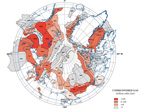|
|
Oil is leaking from an offshore drilling rig in the Timor Sea near Australia’s Northwest coast. Authorities say it will be weeks before the leak is plugged: they are awaiting the arrival of a drilling rig from Singapore to plug the leak.
“This is a potential disaster for turtles, whales, dolphins, sea birds and sea snakes. The oil and gas spill is still not under control and is expected to continue leaking for two months. Depending on winds, the slick could be pushed to atolls like Scott and Ashmore Reef – areas that are globally significant for their unique wildlife,” warns Dr. Gilly Llewellyn, Conservation Manager with the World Wildlife Fund (WWF) Australia.
Currently measuring at least 85 kilometers, the spill is directly in the path of many migrating species, including loggerhead turtles, dolphins, and the pygmy blue whale, a subspecies of its larger relative. Tons of dispersant chemicals have been dropped in the contaminated water.
Llewellyn is especially concerned for sea turtle hatchlings. “[They] spend a huge amount of time on the surface of the water. Unfortunately, this means that recent hatchlings from the beaches and islands of North West Australia could be swimming into the slick,” she says.
Australian media has reported that there may have been a cover-up in the size and scale of the oil leak, after Australian Senator Rachel Siewet, a member of the Green Party, flew over the oil spill and claimed it was worse than people had been told and that it could reach Australia’s coast. She also said that she saw whales swimming near the oil.
Australia’s Federal Resources Minister Martin Ferguson denies Siewet’s report, saying that the spill is far from the coast (80 miles) and is dispersing in the water naturally.
It is estimated the drilling rig has been leaking 470,000 liters a day since August 21st. The rig is owned by Thailand-company PTTEP Australasia.
Related articles
Oil and gas bonanza discovered in the Arctic

(05/28/2009) 30 percent of the world’s undiscovered gas and 13 percent of its undiscovered oil is located north of the Arctic Circle, offering a potential bonanza for Russia, report researchers writing in the journal Science. Assessing natural resources around the North Pole, researchers from the United States Geological Survey (USGS) say the majority of undiscovered oil and gas will be found underwater on continental shelves, providing economic opportunities for countries with Arctic claims, including the U.S., Canada, Denmark/Greenland, Norway and Russia. The largest deposits of natural gas are expected in areas claimed by both Russia and Norway, whereas the most likely place for oil in the Arctic is in the Chukchi Sea, off northern Alaska.
Twenty years on, some birds still haven’t recovered from Exxon Valdez oil spill
(03/24/2009) Twenty years ago today—at 12:04 AM on March 24th, 1989—the Exxon Valdez tanker struck Bligh reef in Prince William Sound causing 10.8 million gallons of crude oil to spill into the sea. The spill decimated the ecosystem and wildlife for 11,000 square miles and became one of the world’s most infamous oil spills. Twenty years later, researchers say that several bird species have yet to recover from the spill.
14,000-barrel oil spill in the Ecuadorean Amazon
(02/27/2009) A ruptured oil pipeline caused 14,000 barrels of crude to spill into a river in the Napo region in northeast Ecuador, an area known for its high biological diversity, reports Reuters.